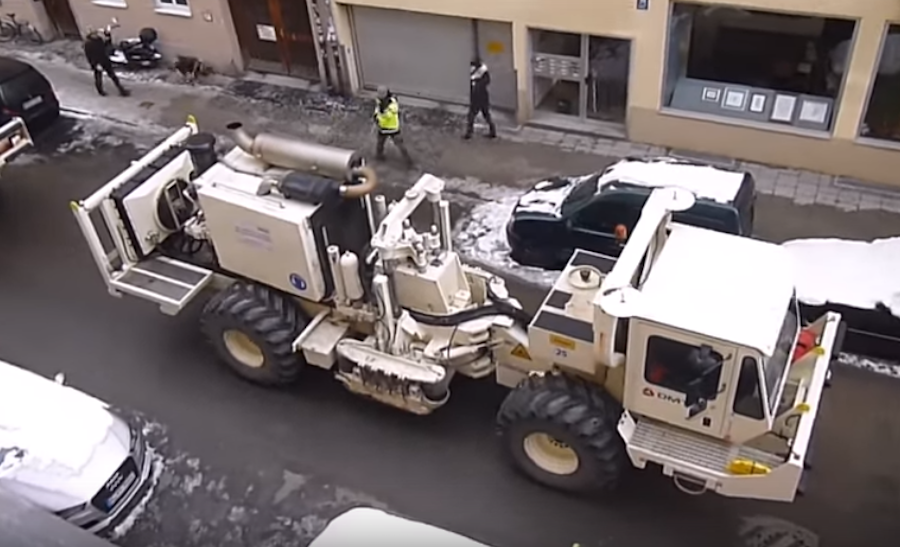Large MT seismic campaign started for geothermal project in Belgium
A large-scale MT seismic campaign has been started in Mons, Belgium for a planned geothermal heating project.
A large-scale MT seismic campaign with vibratory trucks has started earlier this month in in Mons-Borinage, Southwest of Brussels near the French border, as reported by local news. They will travel the region for a month and a half. The result will be the drilling of two wells to a depth of 2500 meters, and the construction of a heating plant just next to Ambroise Paré Hospital. The CHU will soon warm up thanks to these geothermal installations.
The region of Mons-Borinage has a major asset. The basement is filled with hot water. The water has a temperature of 70 degrees Celsius, which already supplies heat to public buildings in Saint-Ghislain, 350 social housing, the station, the pool … Wells are already in operation, ” that represents a saving of 1.5 million liters of fuel oil each year! “says Caroline Descamps the director general of the inter-municipal IDEA. It is possible to do better, say the specialists.
IDEA and UMONS have been working for decades on new geothermal projects to supply Mons and its region. ” For at least 15 years, we wanted to drill geothermal wells to ‘boost’ this energy transition. Caroline Descamps confirms that this took a long time, especially because … all this is extremely expensive. ” In 2013, we took advantage of European funding call for projects to submit our project. In 2017, we received the subsidy agreement. It still represents EUR 16 million.”
It is therefore a question of drilling. But where exactly? What is the most favorable place? How far is this gigantic reservoir of hot water under the feet of the Montois? For the time being, there is a lack of data. Hence the exploring what can be found in the basement. Vibratory trucks will take care of the operation. They will not go unnoticed. Their look is quite special. They also advance at very low speed and stop constantly, to shake the ground. ” They send a signal in the basement, which will reflect on the different layers of the subsoil, ” says Professor Olivier Kaufmann (Faculty of Technology – UMons). ”
“It’s a bit like doing a basement radiograph.” The goal is to better understand the geometry of the reservoir that contains hot water. What is its shape? its structure? We do not know in detail which are the most favorable places to go to collect water, that’s what we try to imagine . “The inspection campaign will last until the end of March It will cost EUR 1 million and the trucks will have to travel through 14 municipalities in the region – no worries, the vibrations are safe. ” Vibration control measures will be carried out along the way to ensure that no nuisance can be caused when the truck passes”Tests had already been carried out in 2012. Without concern for the inhabitants, buildings or roads, we are assured.
The drilling should begin in the spring of 2020. The operation looks delicate. Drilling is expected to go to a depth of up to 2,500 meters. Oil drilling experts will do it. All this will take between six and nine months. Then comes the construction of a geothermal heating plant, mid 2021. David Charlet, head of IDEA’s infrastructure department, takes us to where the plant will be built. ” We are in the Ursulines park, we are planning to build a semi-underground plant, very well integrated in the landscape .”
What will happen inside the building? ” This is where the heat exchange will take place “. There will be two wells, one to collect the water at about 70 degrees. The other to reinject this water, after having extracted the heat. ” The transfer will be in pipes insulated towards the consumers and the closest consumer of the power station is Ambroise Paré”. The hospital signed a contract for the supply of geothermal energy in 2023. It will buy hot water at the price of gas, and this will allow its facilities to run. The plant is built close to the hospital is to minimize the costs. “Drilling and insulated pipes are a very important budget , “confirms Caroline Descamps.
IDEA is considering expanding its geothermal well network. ” We have a potential of about twenty wells on the territory, which can be deployed to supply the whole heart of Hainaut”. For the Walloon Minister of the Budget, Jean-Luc Crucke, it is necessary to reach this objective in 2030. ” 20 doublets like this, 19 more, it is possible” , hammered the minister MR. ” We have to go faster, in the fight against global warming.”
For his part, the Walloon Minister for the Environment Carlo Di Antonio (cdH) insisted on the need to clarify the rules regarding the exploitation of the subsoil. ” This is still a source of concern for local residents, the law must evolve, adapt to current and future changes, and with this type of drilling, we are talking about pumping water and returning it. Permits must be managed differently, we must be attractive to entrepreneurs, but we must ensure that resource management is sustainable.”
Source: RTBF


















